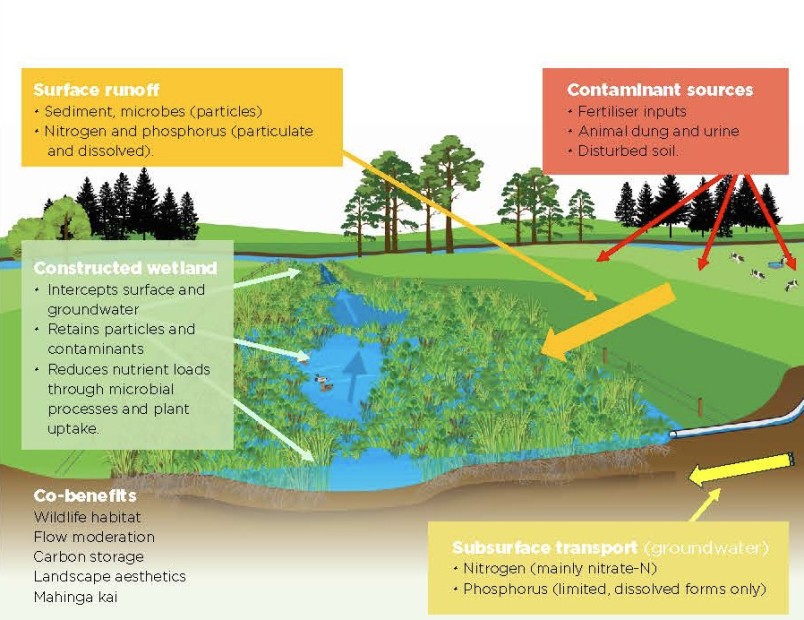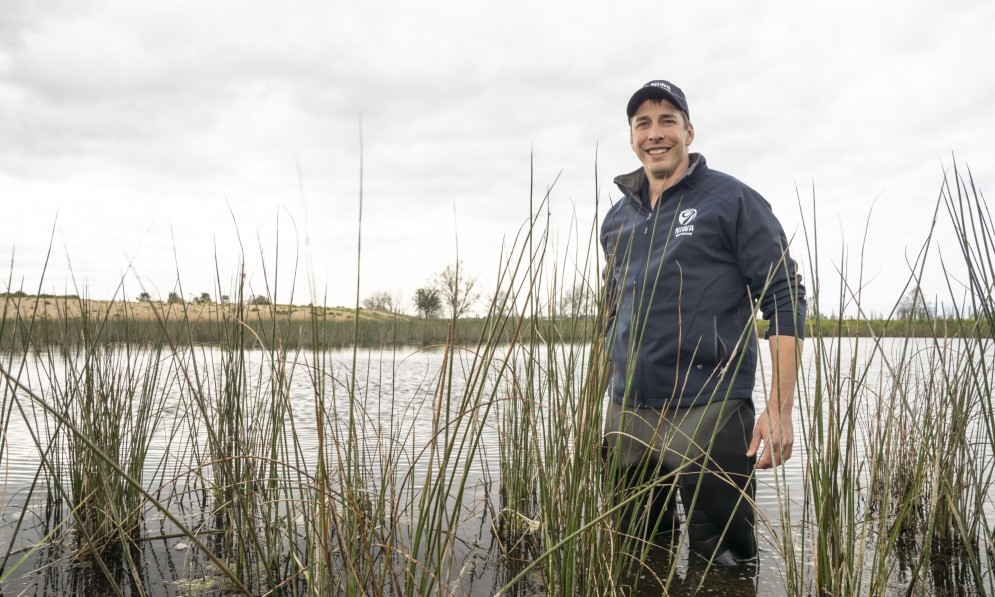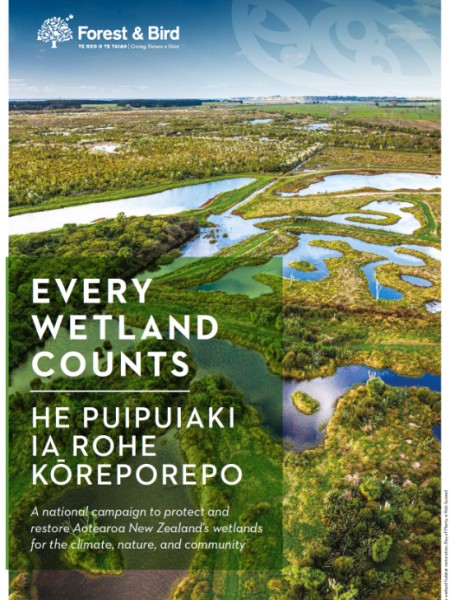A constructed wetland was highly effective at cleaning up freshwater, absorbing up to 80% of key farm pollutants in a four-year NIWA study. By Andrea Rush
Forest & Bird magazine
A version of this story was first published in the Autumn 2024 issue of Forest & Bird magazine.
⏎Well-designed wetlands are increasingly being used as a nature-based method to mitigate run-off and drainage from agricultural land.
Wetlands act as a barrier between agricultural areas and freshwater sources such as streams, rivers, and lakes, offering a natural solution in reducing pollution.
They can significantly soak up excess nitrate-nitrogen and other agricultural contaminants, improving the water quality exiting a wetland and enhancing the ecology of rural catchments.
Owl Farm is a 160ha dairy farm at St Peter’s School near Cambridge. A 0.34ha constructed wetland was built there in 2016 as part of a wider plan to reduce contaminant loads in farm drainage that flows into the nearby Waikato River.
“We wanted to find out how well the constructed wetland wasperforming, and that’s where we began working with NIWA,” says farm manager Jo Sheridan.
The Owl Farm team. From left: Jo Sheridan, Linh Hoang, Chris Tanner, Valerio Montemezzani, and James Sukias.
A team of NIWA freshwater scientists embarked on a four-year project to evaluate the wetland’s capacity for nitrogen removal. Excess levels of nitrate-N can cause toxic algal blooms, reduce oxygen, and kill aquatic life.
The Owl Farm wetland receives a mix of surface water, tile drainage, and groundwater. It is difficult to measure all these different inflows and assess how well the wetland is operating.
Collecting data on the mass of contaminants in the farm run-off is also complicated by the variability of both weather and climate.
NIWA Principal Scientist (Aquatic Pollution) Dr Chris Tanner says collecting enough samples to accurately estimate what’s coming into the wetland, in terms of flow and concentration, and comparing that with that coming out of the wetland was time consuming and prohibitively expensive.
So, instead, they turned to modelling. Although water samples were collected periodically from a well intercepting groundwater seepage, from a tile drain, and from the wetland’s outflow, these samples didn’t yield enough information to accurately characterise the relative inflows from each source.
“To resolve that problem, we developed a linked catchment–wetland mathematical model to quantify inflows to the wetland and measure its contaminant removal performance,” says Dr Tanner.
“This modelling effort, led by Linh Hoang, allowed us to solve a previously unsolvable mystery.”
The Soil Water Assessment Tool (SWAT) catchment model was calibrated to the measured flows and contaminant loads, allowing the team to estimate inflows and contaminant loads in the three dominant wetland water sources heading into the wetland.

The ins and outs of a constructed on-farm wetland. Image NIWA
The wetland model was used to simulate the movement of water and contaminants through the three wetland cells and to estimate the flow and contaminant load entering and leaving the wetland.
The model estimates indicated that the constructed wetland was very effective, removing between 55% and 80% of the inflowing nitrate nitrogen load annually (with an average of 61%).
Removal was greatest when flows are low and during summer, when warm temperatures stimulate plant uptake and the conversion of nitrate to inert nitrogen gas by microbes. Although performance reduced as water flow rates increase, even during higher-flow periods nitrate removal was still maintained at 20%–40%.
Dr Tanner says the linked models were able to successfully simulate the hydrological processes of the catchment and wetland.
“As well as being useful to measure the performance of other constructed wetlands where it’s difficult to directly sample all inflows and outflows, a linked catchment-wetland model provides a tool for predicting the cumulative water quality benefits of wider implementation of constructed wetlands across large catchments,” he says.
The effectiveness of constructed wetlands needs to be measured to determine whether more widespread implementation could be an important part of an effective long-term solution to water pollution.

Dr Brandon Goeller
Biodiversity benefits
Artificially constructed wetlands, such as the one at Owl Farm, are primarily designed and placed within catchments to improve water quality in agricultural landscapes.
But another NIWA study has shown their dual benefits for biodiversity, with the constructed wetland attracting native species, kickstarting a richer more diverse on-farm ecosystem.
Across the country, around 90% of natural wetlands have been cleared. But in the Waikato, that number is even higher, with most of the rural land now dairy farm paddocks.
Study lead Dr Brandon Goeller, NIWA Riparian and Wetland Scientist (Aquatic Pollution), says he wanted to observe the flora and fauna that inhabit wetlands constructed for rural water quality improvement.
“We found the constructed wetlands were useful for putting shallow vegetated and deeper open-water pond habitats back in the landscape,” he explains.
“They provided habitat for invertebrates and fish, and places for birds to hide, nest, and feed.”
“Hardy native wetland plant species such as raupō, kuta, pukio, umbrella sedge, and kuawa that were planted in the wetland at Owl Farm were doing well.”
Scientists identified 113 plant, 20 bird, five mammal, 85 terrestrial invertebrates, 47 aquatic invertebrates, six fish, and two amphibian species across five Waikato constructed wetlands, including Owl Farm.
Mātātā fernbird. Image Oscar Thomas
Native species made up 96% of the total aquatic invertebrate fauna, including dragonflies and caddisflies, but less than half of species in other taxonomic groups (birds, plants, terrestrial invertebrates, mammals, and fish).
“Species with high or fast dispersal capabilities can start using the wetlands soon after they are built. We found plenty of pūkeko, paradise shelducks, and mallards, and tūī when the flax was in flower.
“Creating the constructed wetland habitat just 100m from the Waikato River provided a pocket of habitat for native fernbirds, which was a highlight at Owl Farm,” says Dr Goeller.
“We also found predator species, including rats, feral cats, and possums, at the wetlands, creating competition and predation for native species. Management of the exotic and pest species is needed to boost the benefits to native biodiversity.
“The study confirmed that establishing the wetland has been like kickstarting a richer, more diverse ecosystem.
“Besides improving water quality, constructed wetlands provide ‘stepping stones’, allowing freshwater flora and fauna to reestablish and be better connected through catchments.
“Adapting wetland design and managing them to be ‘dual purpose’ will have positive impacts on biodiversity.”
Constructed wetlands can remove nitrate contaminants, decrease downstream flooding, and provide a valuable habitat for native species. For more information, including NIWA’s guidance on how to design, review, or construct a new wetland, go here.

Image credit: Rob Suisted
Forest & Bird wants to see the number of wetlands in Aotearoa double to help mitigate climate change, clean up waterways, and boost biodiversity. For more information, go here.
⏎
